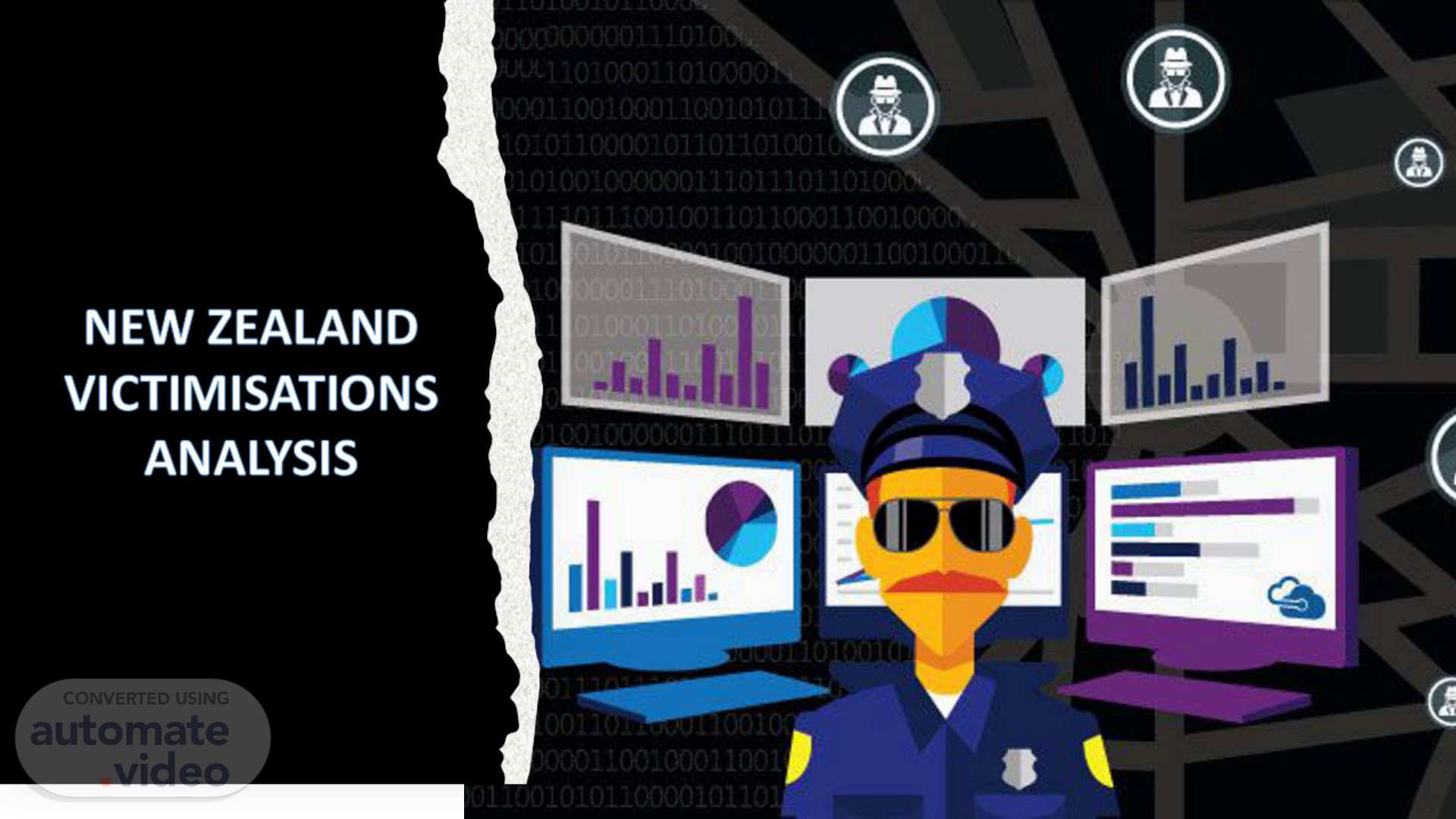Scene 1 (0s)
[image] A cartoon of a policeman in front of computer screens.
Scene 2 (8s)
SCENARIO/PROBLEM. The police force of New Zealand intensified its security operations in order to minimize the number of victims of crime in the locality. • To manage the peace and order situation of the locality. • Identifying the underlying causes and preconditions of victimisations of the locality for reduction and prevention.
Scene 3 (25s)
BUSINESS REQUIREMENTS. Identify patterns and trends, which can then be used to make accurate predictions about future criminal activities in terms of time. Identify the areas with a high incidence of victimisation, and this will help deploy resources accordingly..
Scene 4 (40s)
TARGET AUDIENCE OR STAKEHOLDER. Police officer senior level of rank. Police investigator Government officials Community Peer Tutor.
Scene 5 (50s)
BUSINESS QUESTIONS. What factors contribute to the rates of victimisation? • What patterns and trends can be observed in victimisation? • What is the profile or identification of evolving or existing patterns and series of victimisation?.
Scene 6 (1m 3s)
TARGET VARIABLE. Occurrence Hour of the Day Occurrence Day of the Week Victimisation Month and Year Location Type.
Scene 7 (1m 13s)
TECHNIQUES USED FOR THE ANALYSIS. Data Collection (from the NZ website) Data Wrangling (Power Query) Descriptive Analysis Exploratory Data Analysis (Univariate and Bivariate) Diagnostics Analysis (Hypothesis Testing Chi Square) Statistical Analysis (Statistical Inference) Hypothesis Testing (Pearson Correlation, Linear Regression and Time Series).
Scene 8 (1m 28s)
EXPLORATORY ANALYSIS. [image] VICTIMISATION TIME AND PLACE 242K.
Scene 9 (1m 36s)
EXPLORATORY ANALYSIS. A graph with blue rectangles and white text Description automatically generated.
Scene 10 (1m 47s)
Magnifying glass showing decling performance. STATISTICAL INFERENCE.
Scene 11 (1m 54s)
STATISTICAL INFERENCE (PEARSON CORRELATION). [image] Occurrence Hour of Da Number of Victimisation s 11,681 10,575 9,411 6,152 7, 075 g , 695 14,452 19,736 24,851 33455 32, 354 33 35, 158 33172 2g, gal 25,260 21,802 14 636 15,118 12, 153 11,319.
Scene 12 (2m 10s)
STATISTICAL INFERENCE (LINEAR REGRESSION).
Scene 13 (2m 18s)
STATISTICAL INFERENCE (TIME SERIES).
Scene 14 (2m 25s)
INSIGHTS. Factors Contributing to Victimisation Rates: The analysis suggests a statistically significant correlation between the time of day ('Occurrence Hour of Day') and the number of victimisations. The regression model, while explaining a moderate amount of variability, identifies the 'Occurrence Hour of Day' as a statistically significant predictor of the number of victimisations. However, the location type and occurrence day of the week do not show statistically significant evidence of a relationship with victimisation rates..
Scene 15 (2m 47s)
INSIGHTS. Patterns and Trends in Victimisation: The dataset indicates a right-skewed distribution of occurrences for different crime categories, with "Theft and Related Offences" having the highest number of occurrences. There are substantial differences in the number of occurrences between crime categories, suggesting varying degrees of prevalence. The forecast analysis indicates an upward trend in the number of victimisations over time, with recent data points showing a forecasted decrease. Seasonality is not explicitly mentioned, but there are observable patterns in the data..
Scene 16 (3m 11s)
INSIGHTS. Profile of Evolving or Existing Patterns in Victimisation: The regression model identifies the 'Occurrence Hour of Day' as a significant predictor, suggesting that the time of day is an important factor in understanding victimisation patterns. The decreasing trend in forecasted values for future months and consistently negative errors may indicate a potential downward projection in the number of victimisations..
Scene 17 (3m 29s)
RATIONALE BEHIND THE PRODUCT. The accuracy and reliability of victimisation data are crucial for evaluating the effectiveness of current strategies and measuring police performance. A comprehensive analysis will additionally enhance crime solution and prevention efforts..
Scene 18 (3m 43s)
BENEFITS AND VALUES OF THE PRODUCT DELIVER. This analytical approach is advantageous as it enables the organization to extract insights from victims patterns and trends, ultimately contributing to crime prevention and solutions..
